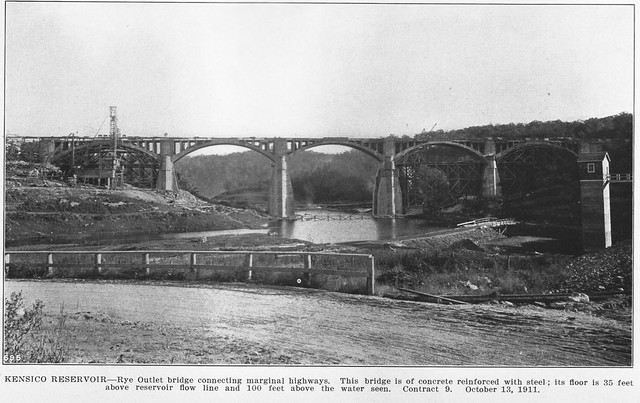
Home > NYC Reports > 1911
During 1911, drawings were completed for the temporary reservoir gatehouse, bridge, aerator, and connection to the waste conduit. The temporary reservoir was known as New Rye Lake. Construction of the temporary reservoir was completed during the year and it began providing water to the Bronx on September 9th. Over 2 miles of 36-inch steel pipe was laid between January 6th and April 29th to connect New Rye Lake to the Bronx Conduit. Lake Kensico as formed by the 1885 dam was drained so excavation of the new dam could begin. The Bronx Dike on the west side of the peninsula was sealed on July 17th and the Bronx-Rye Tunnel connecting the Bronx River to Bear Gutter was completed during the year, allowing the water to flow into New Rye Lake. Three miles of new highways were opened to traffic with another 2.5 miles nearly complete. The Cranberry Brook Bridge (east side near the dam) and Bear Gutter Bridge (northern edge of the reservoir) on what is now NY-22 were also completed. During the year various tests were made on concrete and the granite planned for the Kensico Dam to determine strength and durability. Various full-scale models of parts of the dam were also constructed including a 30x35-foot granite model of part of the top of the dam. Excavation of the by-pass aqueduct was nearly completed during the year and over half of the masonry was completed. Work on the aqueduct progressed 6 days per week, with about 45 feet of masonry being poured every day. The Kensico Dike embankment on the west side of the reservoir was also nearly complete.
The construction of the Rye Outlet Bridge (NY-22 today) continued in 1911. If I have my bearings correct, I think the photographer may have been standing just beyond the end of the current peninsula, quite possibly in the Riley’s yard. I believe the gatehouse to the right in the picture is on the upstream side of the temporary Rye Dike. The bridge was completed during the year except for the northern approach.
The bridge drawings included concrete lampposts topped with bronze ornaments.
The old reservoir was drained during the year and work began on excavating for the new dam. The gatehouse for the old dam is on the right. Planning continued during 1911 with drawings completed for many of the supporting chambers and works for the reservoir. The locations of the expansion joints were determined, as were the locations of ramps, stairs, roads, and fountains below the dam. Work on the new dam began on September 22nd when steam shovels began dismantling the spillway face of the old dam.
Planning and construction of the almost 1500-foot long waste conduit was completed. This conduit is used to take overflow from the spillway east of the dam and channel it to the Bronx River near the Harlem Line railroad tracks. (I hiked by this outflow many times as a child. Every time we walked by the grate covering the large cold dark pipe we always felt like something was going to jump out and grab us.) The conduit is capable of carrying 800 cubic feet of water per second. During construction of the dam, a 618-foot wooden flume was connected from the temporary dike across the Bronx River on the west side of what is now the peninsula to the waste conduit to allow excess water from the Bronx River to bypass the dam work area.
Plans for the waste conduit.
Diagram of the original aerators and small inset map showing the location of the main reservoir outlets and waste channel. There were 1750 nozzles in the aerator. They chose bronze for the nozzle bases to avoid “unsightly rust stains on the concrete”. Because of concerns that the bronze nozzle bases would be stolen from the job site, they were chemically treated to look like cast iron.
The aerator site under construction.
One of the meters that measures the amount of water flowing through the aqueduct. This one is just after water exits the reservoir to the west. It's hard to get a feel for the scale until you notice the gentleman standing in front of it.
Homes acquired by the City were typically used to house employees until they needed to be removed to make way for the rising waters. Those homes not needed were rented to others with a 30-day notice eviction clause. Concerning farmland acquired, the City used the hay harvested from the Kensico Reservoir basin to feed the horses used by the police, the hay being described as of very fine quality. In Camp Columbus on the west side of the reservoir three 32-man houses were added to the “Italian section”, with the camp housing as many as 575 people at its peak during the year. An isolation hospital was also erected during the year. Camp Kensico near the dam site saw a maximum of 754 people during the year. One of the city-owned buildings was turned over to the North American Civic League for Immigrants for use as a camp school, and included an assembly room with a stage and dressing rooms and a playground.
During 1911 a nursery was planted at Kensico to support reforestation of the 2200 acres owned by New York City that would remain above the waterline. In April the City received 70,000 seedlings, 5800 of these being planted on the peninsula permanently and the remainder being planted in a 6-acre nursery for later transplanting.
Home | 1910 Report | 1912 Report | Site Map
Synopsis written by Robert Mortell, 2013.